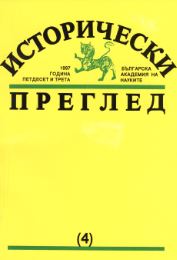Българският вариант на десталинизацията (1953–1956)
The Bulgarian Variant of deStalinization (1953–1956)
Author(s): Roumyana BogdanovaSubject(s): History, Political history, Recent History (1900 till today), Special Historiographies:, Post-War period (1950 - 1989), History of Communism
Published by: Институт за исторически изследвания - Българска академия на науките
Keywords: Eastern Bloc; V. Chervenkov; Stalinist model
Summary/Abstract: The relative change given to Bulgarian to replace an authoritarian regime with a more liberal one and to turn to more flexible forms of totalitarian rule, was one of the most interesting episodes in our post-war development. The material and politico-ideological prerequisites, the system of inter-state and inter-party relations in the Eastern Bloc which traced the road of consolidating the cult of personality of V. Chervenkov also influenced the efforts for its eradication. The point of fact the historical chance for altering the Soviet model in the 1953–1956 period was rather relative. There were no forces to avail themselves of this chance. There was no real counteracting mechanism against the administrative-bureaucratic rule. To carry out de-Stalinization by convinced Stalinists was a task-which exceeded the political possibilities not only of the BCP. For the definitive breaking away from the Stalinist model of administration and leadership in the 1950s there were conditions neither of an internal nor of an international character. The fact that Moscow retained full control over the processes of liberalization brought in question the real chances of the Bulgarian variant of de-Stalinization. The Bulgarian society faced no choice. It was offered a new pattern which was turned into the only true road. Moskow’s measured self-criticism was a preventive step for preserving the stability of the system. It guaranteed the leading role of the CPSU and enabled the Kremlin to dictate the degree of reassessment, to choose a suitable formula, to control the process of democratization and to damp the reformist enthusiasm when necessary. The democratic and liberal tendencies were difficult to manipulate. The new ideas were quickly abandoned as dangerous political ballast. Energetic measures were taken for “curbing the petty-bourgeois element” and for canalizing the processes of renovation.
Journal: Исторически преглед
- Issue Year: 1997
- Issue No: 4
- Page Range: 21-57
- Page Count: 37
- Language: Bulgarian
- Content File-PDF

